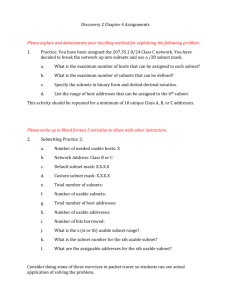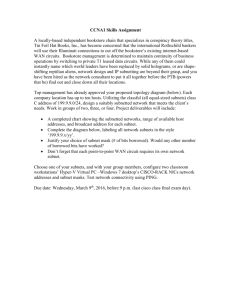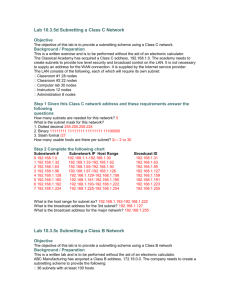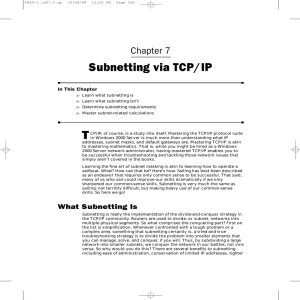Subnets - edtechlearn.org
advertisement
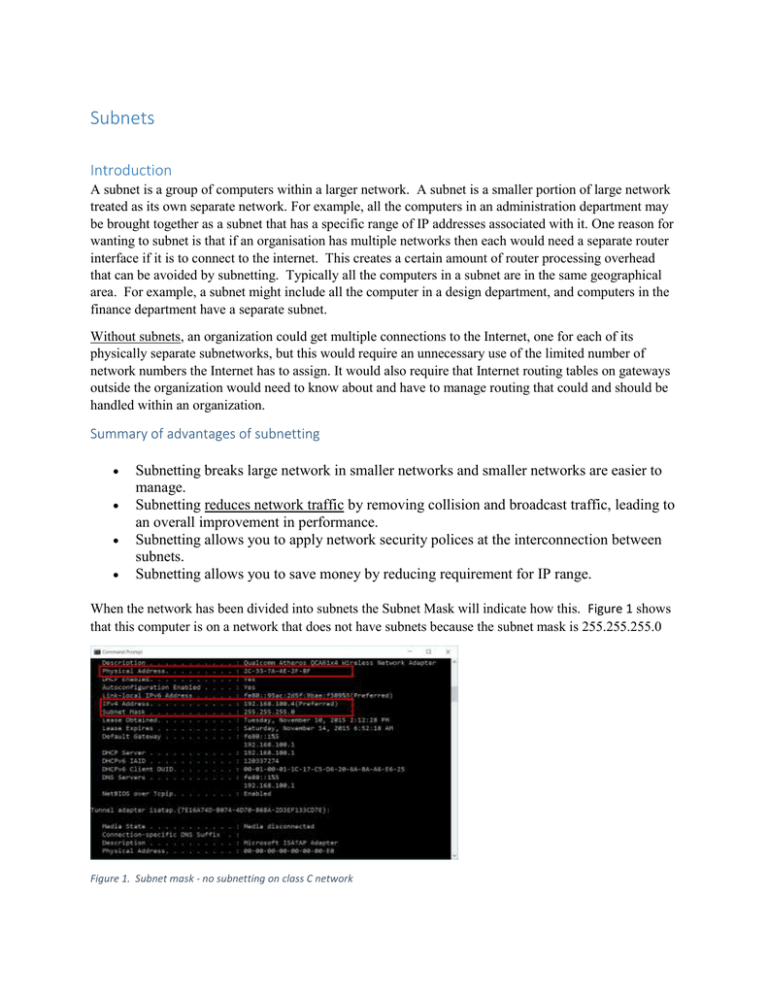
Subnets Introduction A subnet is a group of computers within a larger network. A subnet is a smaller portion of large network treated as its own separate network. For example, all the computers in an administration department may be brought together as a subnet that has a specific range of IP addresses associated with it. One reason for wanting to subnet is that if an organisation has multiple networks then each would need a separate router interface if it is to connect to the internet. This creates a certain amount of router processing overhead that can be avoided by subnetting. Typically all the computers in a subnet are in the same geographical area. For example, a subnet might include all the computer in a design department, and computers in the finance department have a separate subnet. Without subnets, an organization could get multiple connections to the Internet, one for each of its physically separate subnetworks, but this would require an unnecessary use of the limited number of network numbers the Internet has to assign. It would also require that Internet routing tables on gateways outside the organization would need to know about and have to manage routing that could and should be handled within an organization. Summary of advantages of subnetting Subnetting breaks large network in smaller networks and smaller networks are easier to manage. Subnetting reduces network traffic by removing collision and broadcast traffic, leading to an overall improvement in performance. Subnetting allows you to apply network security polices at the interconnection between subnets. Subnetting allows you to save money by reducing requirement for IP range. When the network has been divided into subnets the Subnet Mask will indicate how this. Figure 1 shows that this computer is on a network that does not have subnets because the subnet mask is 255.255.255.0 Figure 1. Subnet mask - no subnetting on class C network Normally a class C network uses 3 octets for the network and For example, Table 1 shows that if we wanted to divide our network into two subnets then we would use the subnet mask 255.255.255.128. The following tables specify how to represent a class C network according to the number of different subnets required. For example, the subnet mask for a network that has 4 subnets is 255.255.255.192 (see the table below). An alternate way to deal with this would be to add /26 after the IP address to indicate that there are 3-4 subnets for the network. Table 1. Subnetting a class C network Required Number of Subnets Number of Subnet Bits Subnet Mask Number of Hosts per Subnet 1-2 1 255.255.255.128 or /25 126 3-4 2 255.255.255.192 or /26 62 5-8 3 255.255.255.224 or /27 30 9-16 4 255.255.255.240 or /28 14 17-32 5 255.255.255.248 or /29 6 33-64 6 255.255.255.252 or /30 2 The subnetting process involves binary math calculation. You must be able to convert decimal to binary and binary to decimal. A subnet is a smaller portion of large network treated as its own separate network. To create subnet we borrow bits from host portion and assign them as network bits. This mean more networks, fewer hosts. IP address 129.3.50.101 Octet 1 11000000 Octet 2 10101000 Octet 3 00001010 Octet 4 01100101 For further information about subnets: https://technet.microsoft.com/en-us/library/cc958834.aspx Book References Peterson, l., & Davie, B. (2012). Computer networks: a systems approach (5th ed.). Burlington, MA: Morgan Kaufmann. Glossary Broadcast address -- An IP address with a host portion that is all ones. Host -- A computer or other device on a TCP/IP network. Internet -- The global collection of networks that are connected together and share a common range of IP addresses. InterNIC -- The organization responsible for administration of IP addresses on the Internet. IP -- The network protocol used for sending network packets over a TCP/IP network or the Internet. IP Address -- A unique 32-bit address for a host on a TCP/IP network or internetwork. Network -- There are two uses of the term network in this article. One is a group of computers on a single physical network segment; the other is an IP network address range that is allocated by a system administrator. Network address -- An IP address with a host portion that is all zeros. Octet -- An 8-bit number, 4 of which comprise a 32-bit IP address. They have a range of 0000000011111111 that correspond to the decimal values 0- 255. Packet -- A unit of data passed over a TCP/IP network or wide area network. RFC (Request for Comment) -- A document used to define standards on the Internet. Router -- A device that passes network traffic between different IP networks. Subnet Mask -- A 32-bit number used to distinguish the network and host portions of an IP address. Subnet or Subnetwork -- A smaller network created by dividing a larger network into equal parts. TCP/IP -- Used broadly, the set of protocols, standards and utilities commonly used on the Internet and large networks. Wide area network (WAN) -- A large network that is a collection of smaller networks separated by routers. The Interne



